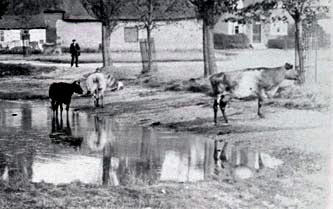Dairy Industry
You don’t have to be a farmer to know that the better bred the cow, the better the profit. Enclosure allowed for the segregation of small herds, enabling farmers to undertake breeding selection. At the turn of the 19th century, landowners and farmers were beginning to take advantage of Southam’s central position on the drover’s cross-roads as a gathering place for the sale and purchase of quality dairy cattle
Southam was renowned for its cheese and it became one of ten specialist places between London and the Midlands where dairy cattle from the Channel Islands were sold outside the common weekly markets. The popularity of Channel Island cattle was due to their small size, the quality of milk and their high feed efficiency – traits already recognised in the 1600s when they are documented aboard ships heading to North America.
By 1795, prizes were being offered for the best cattle at fairs on the Channel Islands and an organised trade brought those prize cattle over to England. By 1811, Michael Fowler, an ambitious Yorkshire man living in Hertfordshire, was the biggest importer of Alderney, Jersey and Guernsey cows and Edward Parsons Fowler became a resident on Jersey, allowing him to advertise “… carefully selected by himself from the richest and best dairies on the Island and being a resident, gives him a decided advantage over other imports.”
During the summer months, the Channel Islands held fairs and the best cattle were judged, often by Michael Fowler himself, and immediately afterwards shipped off to England. The drove of cattle was then pushed north to the Midlands for monthly sales. The cattle were not auctioned, but sold at a set price from a regular venue. The day before a Southam sale, a sale was always held at the “Dog and Gun” Banbury at 4pm, allowing a day to walk the cattle to Southam’s “Horse & Jockey” (now “The Olde Mint”) for 4pm. On the following day at 4 pm a sale was usually held at either Rugby or Lutterworth, or Allesley then 24 hours later at Digbeth.
Publican, James Whitehead Jnr, managed the “Horse & Jockey” through those years and certainly took advantage of the monthly sales in addition to Southam’s Monday Market. Adverts invited customers with; “……begs to inform Nobility, Gentry, Agriculturalists and others….” One of those Nobility was Lord Spencer of Althorpe, whose extensive estates touched Southam. The 3rd Earl Spencer (1782-1845) had a very fine herd of Jersey cows and was one of the principal people involved in the formation of The Royal Agricultural Society of England (RASE) in 1839.
However, the railway was gradually gaining importance throughout England and soon cattle were coming up from London on the railway. Edward Parsons Fowler’s advert in October 1849 stated that this was “his last export of road cattle” for that year and terminated at Southam.
In 1852 the Banbury to Leamington railway line fully opened, bypassing Southam. By now, James Whitehouse was elderly and unwell, and the very last Southam sale in the summer of 1852, although advertised at the Horse and Jockey, was actually held at the Craven Arms. James Whitehead died not long after, bringing a rapid end to a vibrant cattle trading era for Southam. The photograph shows dairy cattle taking refreshment at Long Itchington pond.
If you are interested in local history, contact Southam Heritage Collection. We are located in Tithe Place in High Street, Southam and are normally open on Tuesday, Friday and Saturday mornings from 10am to 12 noon. Contact: 01926 613503 email southamheritage@hotmail.com visit our website www.southamheritage.org and follow us on Facebook: Southam Heritage Collection.


Leave A Comment